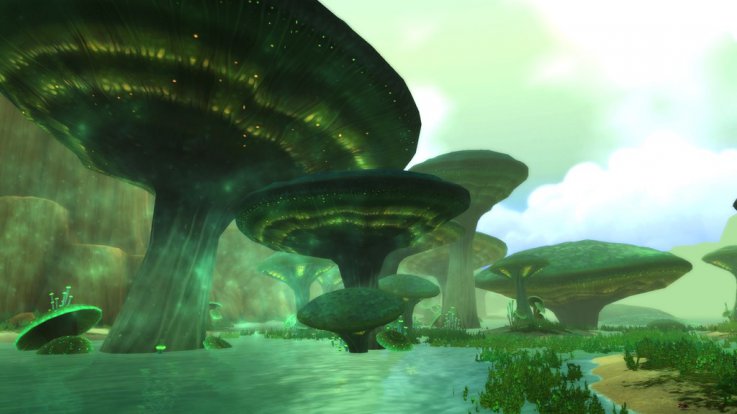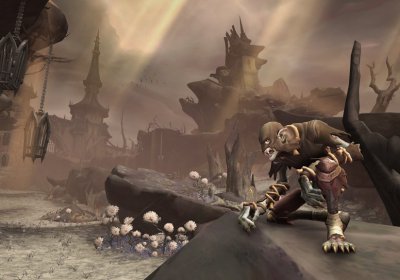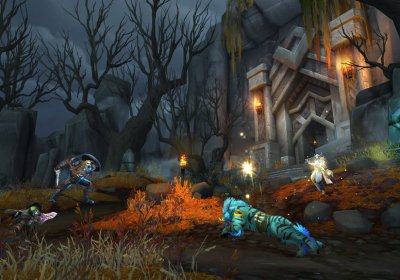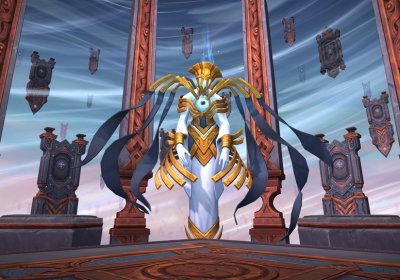WoW: TBC Classic - who rocks, who sucks? Lessons from the private servers

With "The Burning Crusade", a whole lot will change in the classic World of Warcraft. Classes, factions and races that dominate in the vanilla remake will have to give way to better options in Outland. What we can expect in all likelihood, we can already deduce from the various TBC private servers.
- 1st TBC Classic: Horde or Alliance?
- 2nd TBC Classic: Who does the most damage?
- 3rd. TBC Classic: Who tanks best?
- 4th TBC Classic: Who heals best in raids?
- 5th TBC Classic: Which class is the easiest to farm gold with?
- 6th. TBC Classic: Which classes rock the arena?
In our special TBC Classic: No World Buffs, No Pro-Meta? No way! we already looked at how the meta in Outland will fundamentally change compared to the meta of the vanilla re-release. In this article, we're going to go into more detail about how the power structure of classes, factions, and races will shift with TBC Classic, and what we can learn from the various TBC private servers.
Because one thing must be clear to all of us: Similar to WoW (buy now 14,99 € ) Classic, also in TBC Classic experienced private server guilds and players will decisively influence and shape the meta as well as the world-first-race (from the race on level 70 to the first kills across all raid instances). They will establish strategies for gold farming, leveling, arena, and speedruns. At the same time, there will also be new developments, as the TBC versions of the private servers (again: similar to WoW Classic) will differ in detail sometimes more sometimes less clearly from TBC Classic.
TBC Classic: Horde or Alliance?
If you look at the current population figures from Ironforge.pro, 53 percent of all high-level characters that have appeared on WarcraftLogs in recent weeks belong to the Alliance. The fighters under the blue lion banner are even more dominant when we look at the most successful raiding guilds in WoW Classic. Of the 50 fastest guilds in Naxxramas, only 14 belong to the Horde. In fact, there are only two Horde guilds in the top 10. The reason: Paladins.
With TBC Classic, however, the Alliance will lose this crucial advantage: Paladins and Shamans will then be available to both factions. At the same time, some of the Horde races have some very powerful folk skills. Take the Orcs' Boiling Blood, for example, which in TBC no longer just increases attack power, but also spell damage. Or the trolls' tempo buff from Berserker. Or the Blood Elves' Arcane Stream, which they can use to silence enemies and regenerate mana.
WoW: TBC Classic - Thanks to Blood Elf paladins and powerful folk bonuses, the Horde is surging to the number one faction in Outland.
WoW: TBC Classic - Thanks to blood elf paladins and strong folk bonuses, the Horde is rising to the number 1 faction in Outland.
Source: Blizzard
In addition, Horde and Alliance paladins differ in one important detail. Blood Elf paladins use Signets of Blood. Alliance paladins, on the other hand, find Signet of Retribution in their spellbook. The latter spell is more mana-efficient, while the former does more damage to the bottom line. I'm sure you can guess which is more important to many players.
What all of this means for TBC Classic can be seen in the private server communities, where Horde players outnumber Alliance players (61 percent versus 39 percent on a particularly popular one). This is despite the fact that there are often extra advantages for the Alliance on these servers. Alliance paladins, for example, are allowed to use Signet of Blood, Alliance players are allowed to ride for free and receive more honor in PvP than Horde players. Sounds good, right? Still, many choose the Horde.
TBC Classic: Who does the most damage?
The DpS logs of WoW Classic have been dominated by the "Brown Boys" since phase 1. Rogues or mages (thanks to Ignite) can occasionally keep up, but well-equipped warriors have by far the greatest damage potential. In other words: If you want to get through raid instances like Naxxramas particularly quickly, pack as many warriors as possible and supplement them with a few rogues and mages. Add a hunter for the poaching and a warlock for the curses and you have a speedrun raid.
With TBC Classic, this one-sided situation will change fundamentally. The reasons:
- All hybrid playstyles will receive important changes with TBC, thanks to which their support will be even better and they will be able to deal noticeably more damage at the same time. In other words, no raid wants to be without Shadow Priest, Reinforcement Shaman, Elemental Shaman, Balance Druid, Feral, or Retribution Paladin.
- The increased damage potential of many specializations is also due to the next point: all playstyles that rely on damage-over-time effects can now take advantage of them thanks to the significantly increased debuff cap.
- Raid size shrinks from 40 to 25/20 to 10, and specializations become more important, which can noticeably increase raid performance through important buffs and debuffs.
- In TBC, there are significantly more boss fights where melee fighters are at a disadvantage or where ranged fighters can more easily achieve high damage numbers. Raid groups that rely primarily on offensive warriors and rogues, as in WoW Classic, make things unnecessarily difficult for themselves.
- So who does the most damage in Outland? Well, that depends. In most boss fights, Destruction Warlocks and/or Beastmaster Hunters actually dominate. Every now and then, however, Mages or Elemental Shamans show up pretty high up. And as you progress through the raid, Warriors and Rogues start to make their way into the top 30, especially if they have the Illidan Wargleves. In TBC's final boss, Kil'jaeden, even rogues dominate the DpS logs, and without their top damage, the fight is much harder. But don't think the old melee dominance is back in Sunwell Plateau. In M'uru, for example, the top 30 is almost all Warlocks. In Brutallus as well as the Eredar twins, on the other hand, hunters rock the stats.
WoW: TBC Classic - Warlocks have some of the highest damage potential across all tiers in Outland.
Source: Blizzard
There are three things to keep in mind with all of this. Number 1: The top DDs on the private servers are also at the top because they are in an optimal group for them. Some buffs, such as totems, only affect those in your group, even in TBC Classic. Beast Lords fighting alongside a Feral Druid and a Shaman will do significantly more damage than Beast Lords packed next to Spellcasters. And if Destruction Warlocks are thinking about their perfect group, Elemental Shamans and Balance Druids should play a big role. Plus: On private servers, it's quite common to rotate shamans into the best DpS groups one at a time, so they can ignite combat frenzy/heroism there. Unlike in retail WoW, the powerful buff in TBC doesn't leave a saturation debuff yet. Anyone who isn't in those groups will go away empty handed.
Number 2: On many TBC private servers, adjustments have been made to raid bosses to make them more challenging. In other words, some of the tuning there is significantly harder than it was in the original, unattenuated version of TBC. When tuning the raids of TBC Classic, it could well be that Blizzard uses patch 2.4.3 with all the nerfs that have been applied to date as a basis. In that case, it probably won't matter at all which damage experts you pack or whether or not you use other minmaxing strategies (drumming, shaman rotation). But WoW Classic shows nicely that many guilds want to get the most out of it even then.
Number 3: We already hinted at it: within the TBC era, the power structure among damage specialists will shift sometimes more sometimes less noticeably. Some playstyles simply scale better with stronger gear than others. Additionally, the gear available can cause a shift for other reasons as well. We already mentioned Illidan's wargleves. Another example is a bonus from the Mages' Tier 5 set that causes Arcane to suddenly shoot through the roof - especially if the Mages are properly supported (such as with a Shadow Priest) and the battles will be fairly short due to the patch 2.4.3 state.
TBC Classic: Who tanks best?
In the TBC era, we can look forward to three full tank specializations, each with their own advantages and disadvantages. In most raids, a Warrior is likely to take over as the main tank from Day 1. He reaches crit immunity very quickly, has access to a versatile selection of tank tools, and generates good threat stats early on. Additionally, he does not make a good off tank. Unlike in WoW Classic, tanking warriors don't rely on an offensively designed Fury Prot skill. Instead, they go deep into the protection tree. This way they take more AND generate more aggro. However, if they don't get gobbled up, they don't get much rage with their protection skill. Their damage is meager.
WoW: TBC Classic - Whether Druid, Warrior, or Paladin, all three classes make a good tank.
Source: Blizzard
When it comes to tanking large groups, the protective paladin is the first choice. For heroic dungeons, there is no better tank, especially if you have two warlocks in your party. And even the 10-player raids from the TBC era can tank well-equipped, experienced Protection Paladins almost entirely solo. Plus, it brings important support and scales tremendously well with gear. On the other hand, equipping the Protection Paladin and achieving crit immunity without neglecting aggro generation is a bit more difficult than with the Warrior in the beginning.
At the beginning of the TBC era, the ferocity druid is the perfect offtank. He can switch into cat form and deal damage when needed, or tank a boss or numerous adds as a bear. His generated threat is unparalleled across all tier levels. At the same time, he reaches tremendously high armor and stamina levels early on. The downsides? The lack of defensive cooldowns, the need to change form to throw in consumables in combat, and the fact that (unlike the other tanks) they can't become immune to Crushing Blows at any time. This latter weakness isn't relevant on all bosses, however. Almost all of the Sunwell Plateau nasties, for example, cannot hit characters with a Crushing Blow. Many private server guilds there even target Druid tanks because they have more armor and health than their tanking counterparts.
To make a long story short, you'll get the most out of your raid if you have a Protection Warrior, Protection Paladin, and Fierceness Druid in your ranks. If need be, however, all other combinations are possible.
Only paladins can be found in the lists only sporadically. No wonder, since they are mostly used as pure tank healers - a task they can fulfill very efficiently in TBC. At the same time, TBC has a lot more group damage coming into the raid than WoW Classic, so Shamans, Druids, and Priests can easily shine with their group heals and HoTs. So, as far as the healer's job is concerned, don't fret. All four specializations are important and welcome in raids. Shamans are the most likely to end up in the raid multiple times, mainly due to their totems and Battlelust/Heroism.
TBC Classic: Which class is the easiest to farm gold with?
When it comes to farming gold efficiently solo in WoW Classic, there's no getting around mages. No other class is able to shoot such large trash groups out of existence in the open world or in dungeons so easily. This is possible not only because they can slow down the nasties with their Frost spells and kite them so easily, but also because they deal the same damage to all enemies with their AoE spells - no matter how big the pull is.
However, the latter was changed back in patch 2.2. Suddenly, Blizzard and the Frost Nova (as well as other AoE spells of various classes) had a cap on the amount of damage you could deal to targets with the spell. We're pretty sure this change will be in place by the time TBC Classic launches. If we're right, you won't be able to master big pulls as efficiently as you currently can in WoW Classic.
WoW: TBC Classic - Frost Mages are no longer the "Kings of AoE-Farming
Source: Blizzard
However, there are isolated area effects that were not affected by patch 2.2. These include the consecration of paladins. At the same time, Protection Paladins with TBC Classic swing to be the best tanks when it comes to tanking large groups of enemies. And in fact, being a "Prot Pala" in the Outland era makes it easier than any other specialization to successfully implement AoE farming strategies solo in the open world or in some dungeons, raking in lots of gold. Especially when the enemies consist of undead and demons, such as in Stratholme. With a little practice and the right equipment, they can pull together and bomb away a large portion of the Classic dungeon in one pull. At the same time, Prot Paladins, with their tanking prowess, are a welcome guest in any group tackling a Heroic dungeon. So welcome, in fact, that you might even bag some pocket gold for your services or secure the Urnether from the final boss. And even when boosting low-level characters, protection paladins will outrank mages.
And what about druids? They could farm resources super easily with their epic flight form in the open world, right? Well, that was only the case for a fairly short time. The Epic Flight quest line was introduced in patch 2.1, and by patch 2.1.2 it was no longer possible to pick herbs while in Flight.
The good news is that thanks to daily quests and the numerous useful professions, you can farm gold in TBC Classic regardless of your class. The biggest problem will be that the most popular farming locations in Outland will be completely overfarmed due to the supposedly large number of players.
TBC Classic: Which classes rock the arena?
Source: Blizzard
The private servers show that the best class combinations have hardly changed over the years. Combine a rogue or warlock with a healing druid or priest and you're on the right track in 2vs2. The Druid in particular is so strong as a medic that it also works well with various other damage experts like Warriors or Hunters. Occasionally, teams of Retribution Paladin and Restoration Shaman can cause a surprise. In the 3-player range, you'll do well to add a third playstyle to the combinations I just mentioned. The familiar "RMP" of Rogue, Mage, and Priest will also work wonderfully in TBC Classic. A warrior, for example, goes well with a warlock and a druid. In this bracket, however, teams with shamans also appear more often, for example with Druid, Hunter or with Priest, Warlock.
And what about the 5-bracket? After all, this is where you get the most points for your score, and it's also where the balance is best. Playstyles like Holy Paladin, which are at a disadvantage in the 2 and 3 brackets, do much better there. However, the effort in terms of scheduling and such is also higher. At the time, it was already the most unpopular arena bracket, and even on many private servers, 5vs5 is hardly played at all.
Note in all of this that the extra years of experience in TBC Classic's arenas will show up. The average arena player will be more skilled than they were back then. Healers will play more aggressively, much like they do in retail WoW. Overall, it will be harder to secure the Gladiator title over the four seasons than it was back then.


